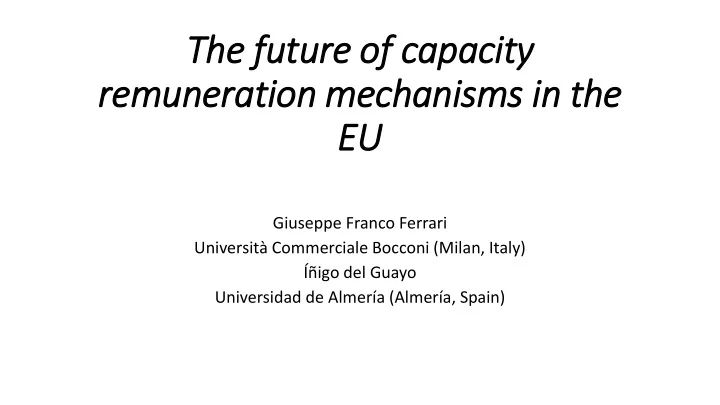

The future of capacity remuneration mechanisms in in the EU EU Giuseppe Franco Ferrari Università Commerciale Bocconi (Milan, Italy) Íñigo del Guayo Universidad de Almería (Almería, Spain)
Capacity Mechanisms and the Principles Governing the Electricity System • Security: it is the aim of the mechanisms • Economic Efficiency: they must not distort markets • Sustainability: within a electrified electricity system dominated by renewable energies, which are intermittent and need back-up
Fundamentals of market liberalization • When the process of liberalization started, promoters thought that markets would always provide signal about where and when to invest • The development of the process has lead to deepen the distinction between free electricity activities (production and supply) and regulated activities (transport and distribution)
The ‘missing money’ problem (I) • When the price of electricity in the energy markets does not provide sufficient remuneration to cover the fixed costs of capacity • Investors lack incentives to build new capacity and may want to close capacity • Maximum prices fixed by the regulator were the first justifying argument for the introduction of a regulatory incentive for the construction of new generation capacity (CRM)
The ‘missing money’ problem (II) • If the price is not allowed to reflect scarcity situations, the incentive to build the necessary plants to avoid supply cuts disappears • The remuneration from market price in the short term is insufficient to recover the investment in all the plants needed to satisfy the demand efficiently • The ‘missing money’ is due to the artificial limitation of the price in situations of shortage (which should be equal to the price that is willing to pay the demand for not being interrupted)
The Debate (I) Do we need additional remuneration for conventional power plants, in addition to income from the energy market?
The Debate (II) • The price of the wholesale electricity market (the "only energy" market), should be sufficient • However, that wholesale price may be unable to provide the necessary signal • It may become necessary a regulatory mechanism that either helps to invest in new generation capacity or rewards those other resources (e.g. storage, demand management) that provide security (reliability) when some other intermittent technologies (such as renewables) fail
Capacity mechanisms in the European Union • In some Member States capacity mechanisms have been introduced • The European Union views these mechanisms with suspicion (a real threat to free competition in the market) • The European Commission is prepared to approve some aid schemes: Guidelines on State aid for environmental protection and energy 2014-2020 (EEAG) • Regulation 2019/943, 5th June 2019, Internal Market for Electricity
The future of capacity mechanisms in the European Union. Regulation 2019 (I) • Role of capacity remuneration mechanisms in the EU • CRM are measures taken by Member States to ensure that electricity supply can match demand in the medium and long term • Designed to support investment to fill the expected capacity gap and ensure security of supply • CRM offer additional rewards to capacity providers, on top of income obtained by selling electricity on the market, in return for maintaining existing capacity or investing in new capacity needed to guarantee security of electricity supplies • An impact on competition (State aids)
The future of capacity mechanisms in the European Union. Regulation 2019 (II) • Chapter IV of the 2019 Regulation (Resource Adequacy) • CRM must be based on a methodology of evaluation of resource adequacy through shared resources (European Resource Adequacy), prepared by ENTSO-E • To cause the least possible disruption in the internal market • Clear and transparent criteria, to i) minimize the distortion in cross- border trade, ii) promote the use of the demand response and iii) reduce any effects that harm decarbonisation, avoiding isolated national mechanisms in terms of capacity that would create new barriers in the market and undermine competition
The future of capacity mechanisms in the European Union. Regulation 2019 (III) • It specifies how and under what conditions capacity mechanisms can be introduced in a manner compatible with the market, including the rules for participation of capacities located in another Member State and for the use of interconnection • It establishes how regional operational centres, national TSOs, ENTSO-E and national regulators through ACER will participate in the development of technical parameters
Summary (Art. 22) Any capacity mechanism shall: • (a) be temporary • (b) not create undue market distortions and not limit cross-zonal trade • (c) not go beyond what is necessary to address the adequacy concerns • (d) select capacity providers by means of a transparent, non-discriminatory and competitive process • (e) provide incentives for capacity providers to be available in times of expected system stress
Summary (Art.22) • (f) ensure that the remuneration is determined through the competitive process • (g) set out the technical conditions for the participation of capacity providers in advance of the selection process • (h) be open to participation of all resources that are capable of providing the required technical performance, including energy storage and demand side management • (i) apply appropriate penalties to capacity providers that are not available in times of system stress • Specific requirements when the capacity mechanism has been designed as a strategic reserve • Limits to polluting generation units (coal)
CAPACITY MECHANISMS IN ITALY AND SPAIN • Spain: suppressed in 2018 • Italy: EC Decision in 2018
Recommend
More recommend